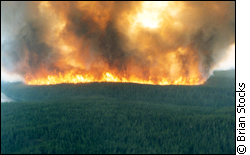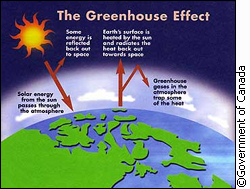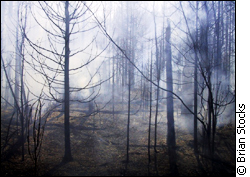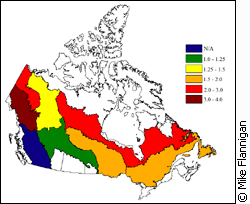
|
But Flannigan isn’t relying on a crystal ball or palm reading for his predictions. Instead, he’s counting on science to look into the future of forest fire behaviour. Flannigan isn’t your typical scientist. He never wears a lab coat and he doesn’t examine organisms under a microscope. Instead, through his thinly-framed glasses, he studies statistics on a computer screen. And, rather than mixing chemicals in a test tube, he programs his computer to blend mathematical equations. Flannigan, who works at the Great Lakes Forestry Centre in Sault Ste. Marie, Ont., specializes in creating fire behaviour models. He works with a team of scientists from various forestry centres within the Canadian Forest Service. They research forest fires, compile data and perform statistical analysis with the help of computer programs. If complex math equations and forest fires don’t sound appealing, consider this: Flannigan’s current model is looking at how forest fires will impact the environment in the next 35 to 55 years. "Fires are so much more than just all the smoke and flames you see on TV," says Flannigan. "These things are letting off greenhouse gas emissions."
A burning issue Human-caused greenhouse gases, like those caused by burning fossil fuels, are responsible for the majority of greenhouse gases that are released into the atmosphere. In Canada, forest fires only emit 20 per cent of what fossil fuels give off. But just because forest fire emissions are relatively small right now, they might not stay that way. Since many scientists predict climate change will increase temperatures and lead to drier vegetation, Flannigan says we could expect more fires in the future. Increased forest fires could lead to more greenhouse gas emissions. Flannigan’s current model will predict how much greenhouse gas emissions we can expect from forest fires in the future. When a fire burns and smoulders, gases, some of which are greenhouse gases, are released into the atmosphere. And the release of greenhouse gases doesn’t stop there. Soils, often covered by burned leaves and needles, can continue to release gases for up to 100 years after the fire has died out. Research scientist Mike Wotton, who works with Flannigan, says a weakness of their current study is that it doesn’t account for greenhouse gas emissions from soil and vegetation. "Right now we’re just looking at the burning of the fire," says Wotton. "Maybe we’ll take other factors into account later on in the future. They’re highly likely to be adding to greenhouse gas emissions." How it works Greenhouse gases are like wool blankets: they trap heat and as a result warm the area around them. When the sun’s short wavelength radiation beams down onto the earth, it passes through the atmosphere and is absorbed by the earth’s surface, causing the earth to heat up. Some of this absorbed energy is then reradiated into the atmosphere in the form of long wave infrared radiation.
The problem is that a lot of the re-radiated energy can’t pass through the greenhouse gases in the atmosphere. The gases absorb these waves and send them back downward, causing the atmosphere to warm even more. Since Flannigan can’t travel into the future, he decided to combine aspects from two previous modeling studies to estimate future greenhouse gas emissions from forest fires. Blazing into the future To estimate future area burned, the team will first calculate how much area has burned in the last nine years. Since their previous study only collected information until 1997, they’ll need to update their database. The team will gather fire data like start date, location and cause from the Canadian Large Fire Database, which the Canadian Forest Service and fire management agencies have been developing since the late eighties. They will also collect weather data, like temperature and precipitation, as well as information about soil moisture.
The next step is to run a process called 'linear forward stepwise regression' using a computer statistics program called SAS. This regression method will select the data that is most related to the area burned. The goal of this process is a lot like the goal of a baseball coach: to choose players, or variables, that work best with the team, or study. One model is never enough But since the fire, weather and soil data is information from the past, the team needs a way of estimating future activity. The solution, according to Flannigan, is to use general circulation models, which are estimates of future climate variables. The team will take data from the circulation model and will use it in place of the fire, weather and soil data. The team is able to make this replacement because past research has shown similarities between the circulation models and the three categories of data. For example, let’s pretend that past research suggests that cause of fire is highly related to temperature, which is one of the circulation model variables. The team would use temperature as the new variable to help estimate future area burned. Currently, Canadian forest fires burn about 25,000 square kilometres of land each year, which is roughly four times the size of Banff National Park. In the study that the modeling approached was based on, published in the journal Climatic Change in 2005, the team estimated that Canadian forest fires will burn 74-118 per cent more land by the end of the century. If this trend continues, some plant species could become extinct. "As fires become more frequent, the trees might not be able to reach sexual maturity," says Flannigan. "I don’t think we’ll see that in this century, but in the next century it could be possible the forest will go beyond anything it has seen in recent memory."
The second model the team will base their current research on comes from a 2001 study published in the Canadian Journal of Forest Research. Flannigan’s team estimated carbon emissions for about 11,000 forest fires between 1959 and 1999. The study estimated that an average of 27 million kilograms of carbon is released into the atmosphere each year, which is equivalent to more than 59 million pounds of carbon. The current research will focus on one particular aspect of the study: the amount of fuel consumed in a fire. The team will use the Canadian Forest Fire Behavior Prediction System, a computer model that the Canadian Forest Service developed. The system calculates variables like moisture in the leaves, the amount of fuel on the forest floor and how fast the fire burns. Crunching more numbers And the calculations won’t stop there. Since fire management agencies don’t record the end dates of fires, Flannigan’s team has to figure them out. The team will use a graph that will calculate fuel consumption against time, which will be measured in days. When the curve of the graph starts to fall, the team will estimate that the fire is over. Combining the modeling approaches from the two studies, the team is beginning to collect data and develop calculations that will multiply the average fuel consumption by the area burned to estimate future greenhouse gas emissions. "How much fuel is consumed directly leads into how much carbon and other greenhouse gases are emitting into the air," says Flannigan.
Later, the team will come up with fractions that will help them identify how much of each individual greenhouse gas is emitted from forest fires. The study should be finished within the next five months. If the study estimates that greenhouse gas emissions will increase in the future, Flannigan doesn’t know what the solution would be. But, if these emissions are caused by an increased number of fires, one thing is certain: putting out more fires won’t be the answer. "The Smokey the Bear syndrome that all fire is bad just isn’t true," says Flannigan. "Although preventing some fires is a good message, we have to remember that in many ways fire is a natural and essential part of maintaining the forest." Adding fuel to the fire For now, Flannigan says he’s happy knowing that his research helps larger environmental studies. For example, his work assists the carbon accounting team of the Canadian Forest Service in working on projects like the United Nations Framework Convention on Climate Change and the Kyoto Protocol. "Mike Flannigan is a fire expert," says Ed Banfield, one of the Canadian Forest Service’s climate change researchers. "A modeling group like ours draws from experience and expertise from all kinds different areas, like harvesting, insects and fire." When it comes to predicting Flannigan’s future, no crystal ball is required: he says he’ll be playing with fire for many years to come. "We’ll keep working on new models to see what we can come up with," says Flannigan.
|
|
|



